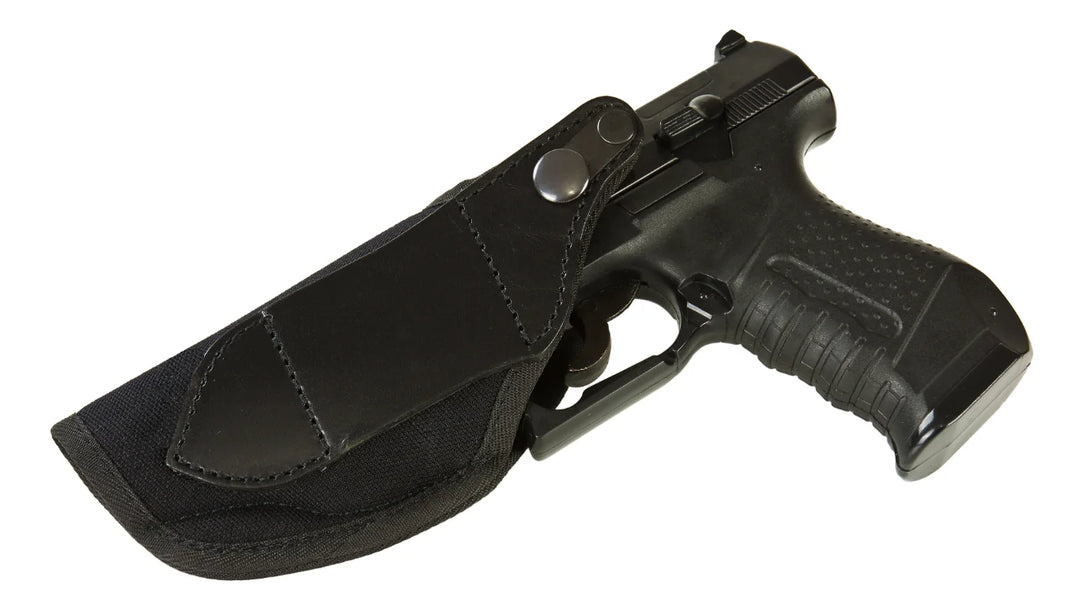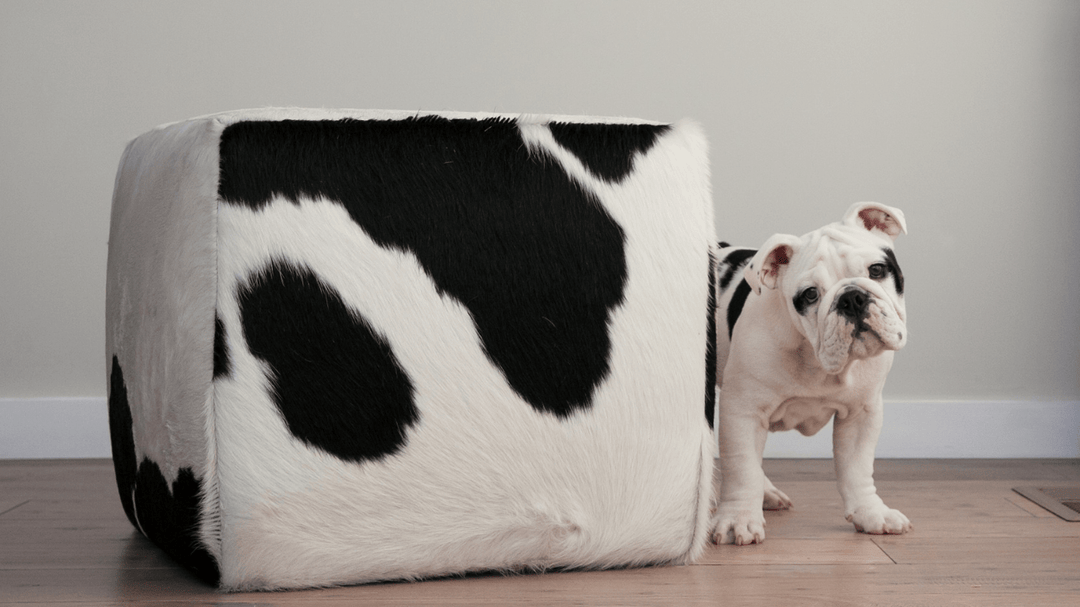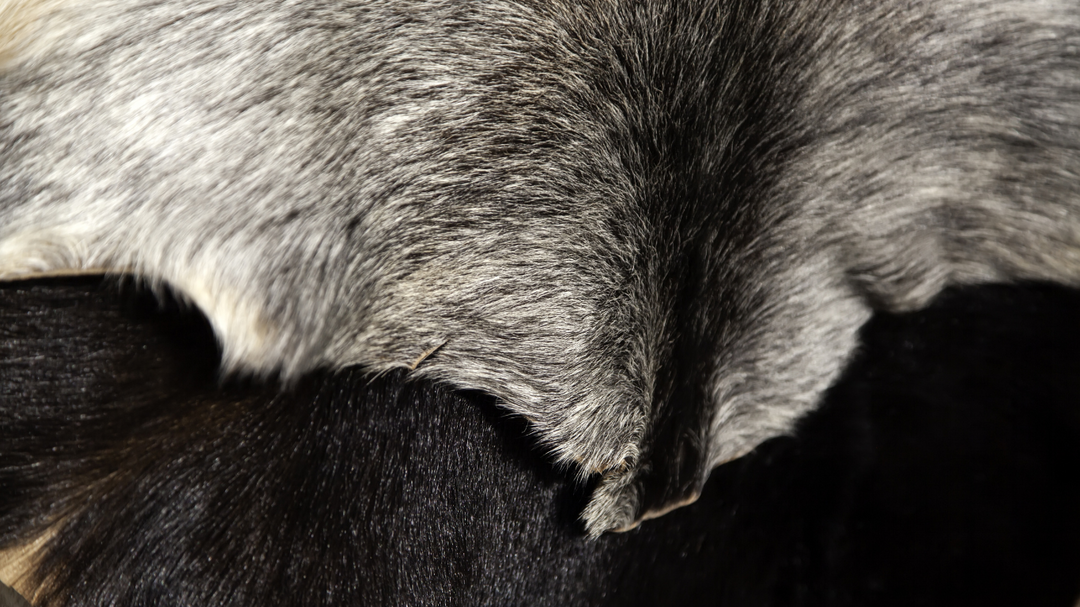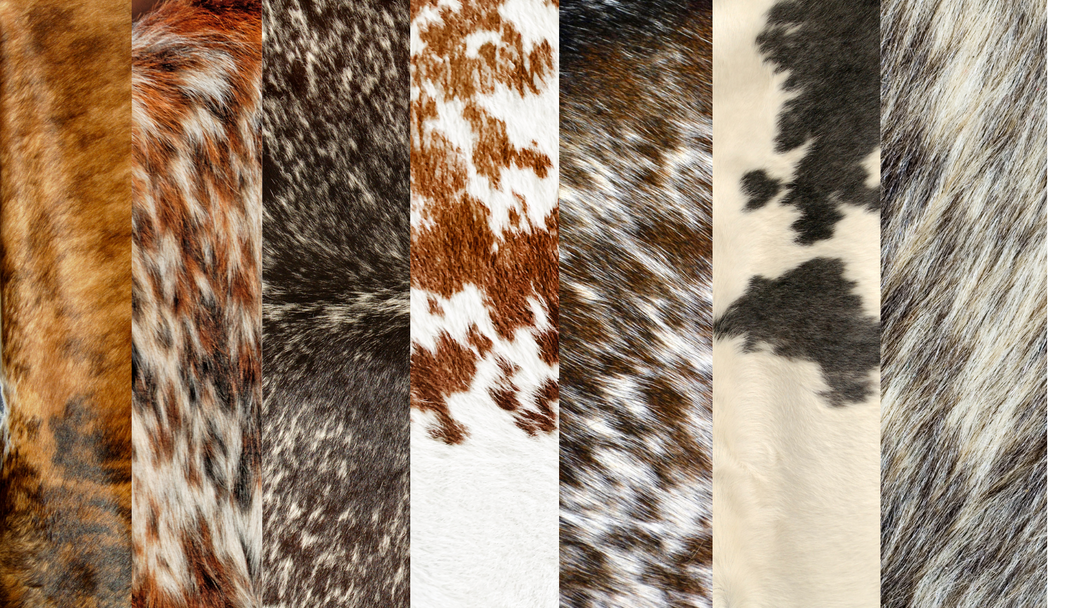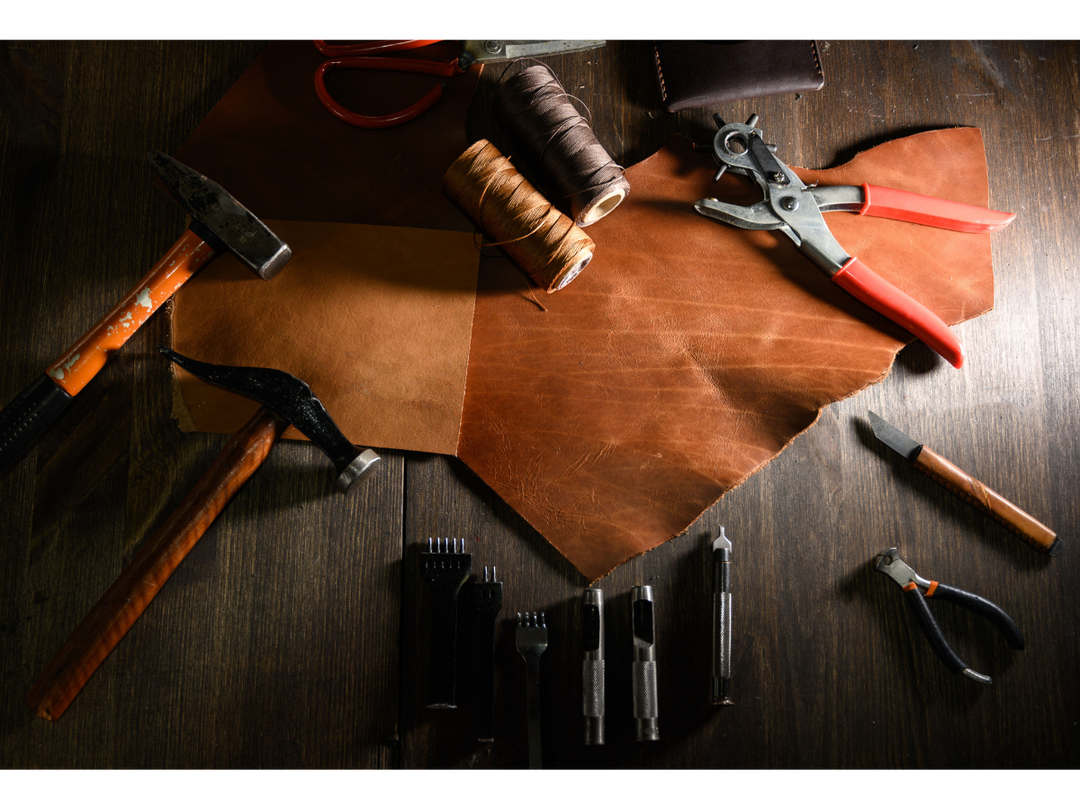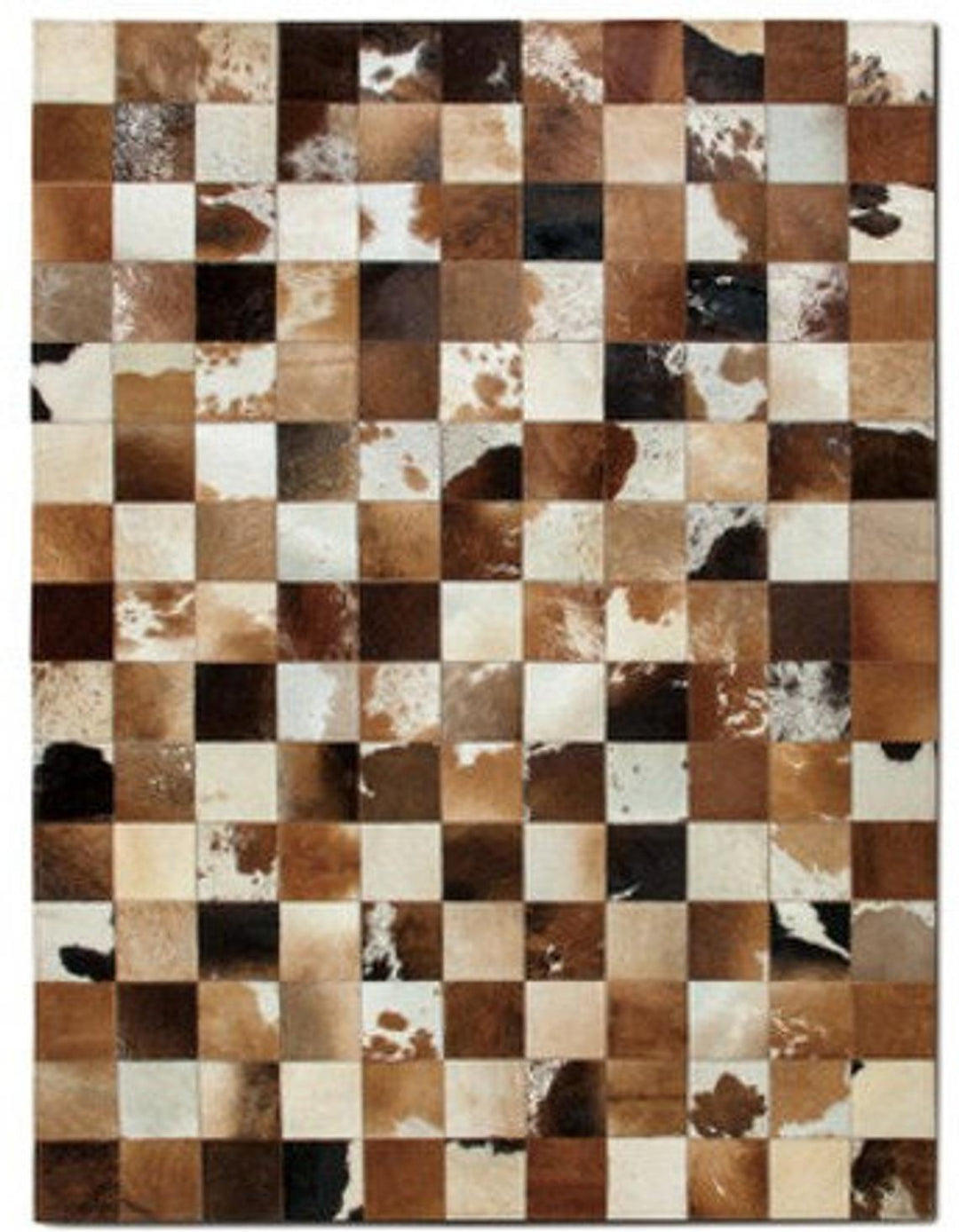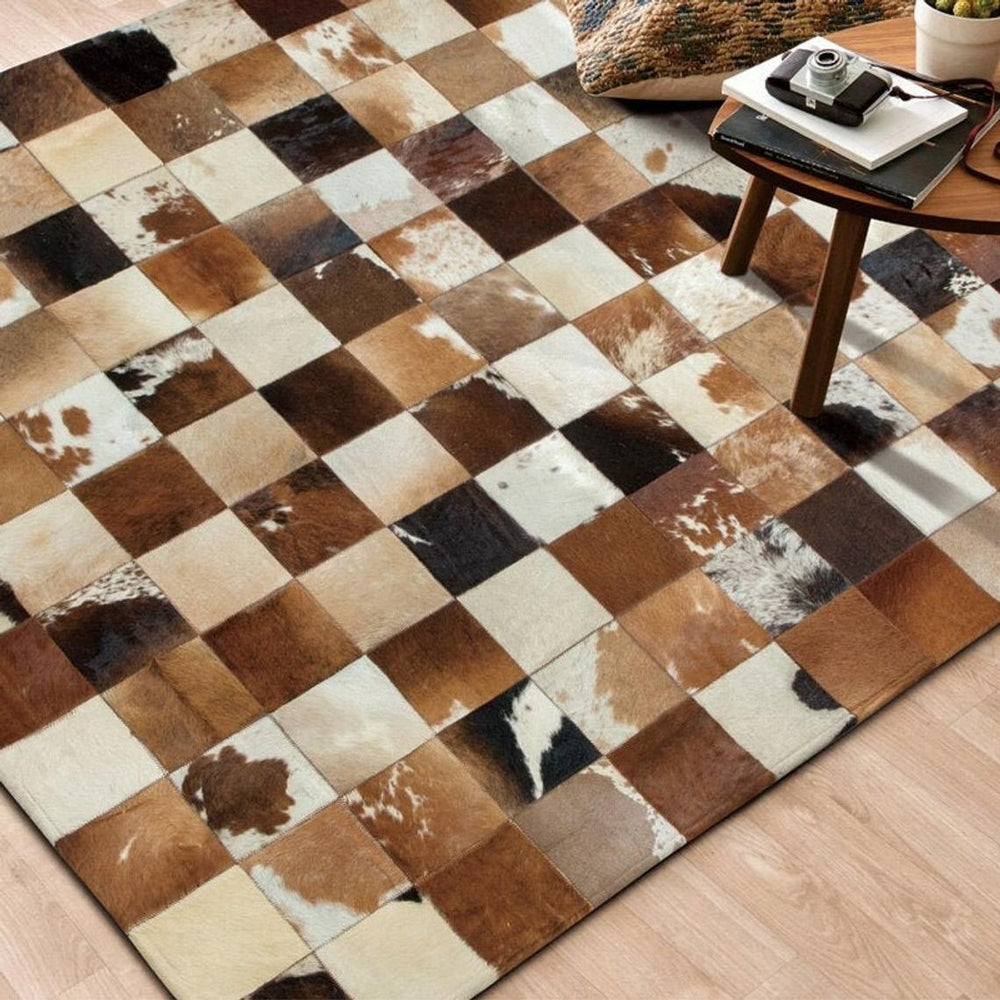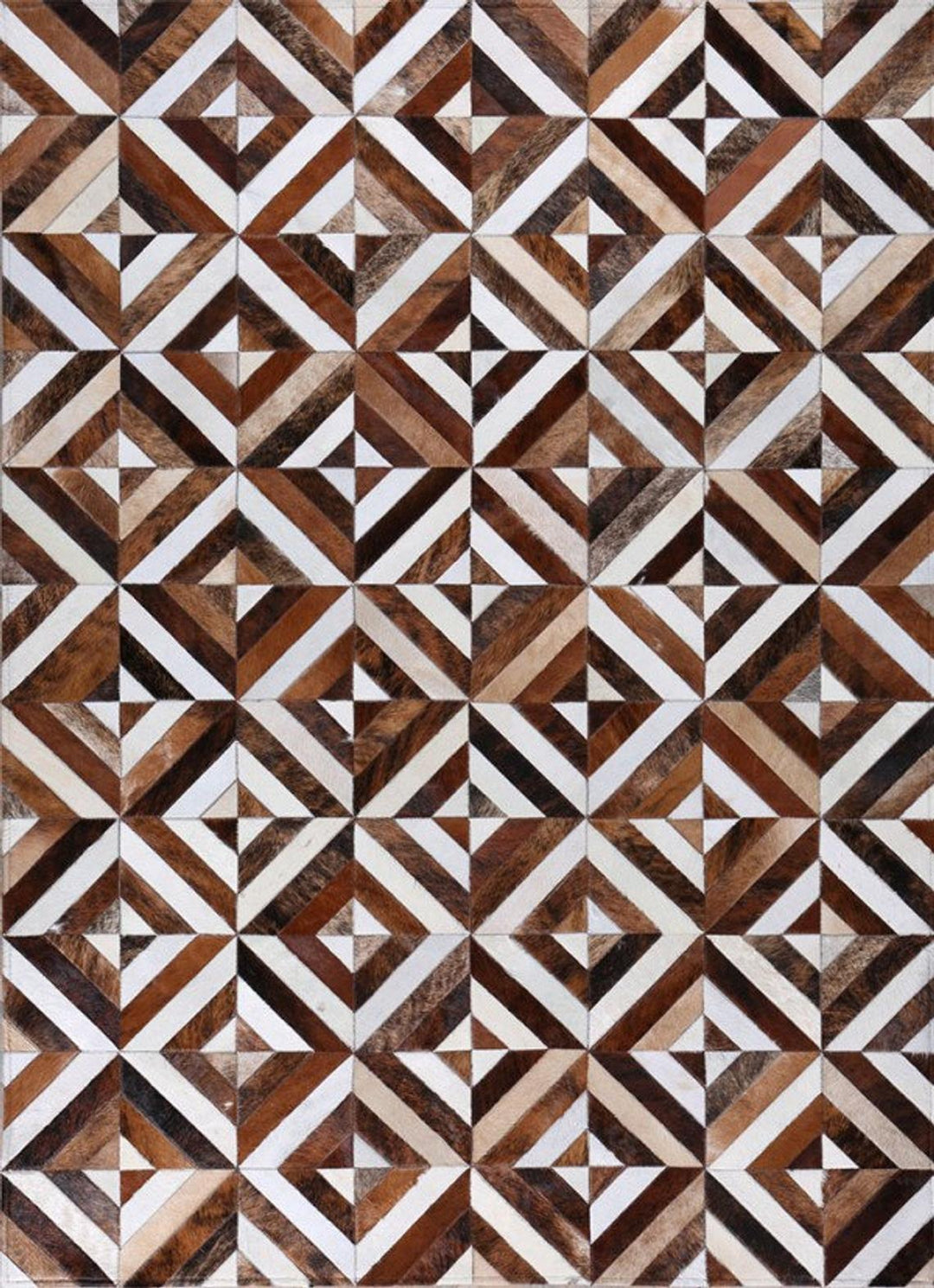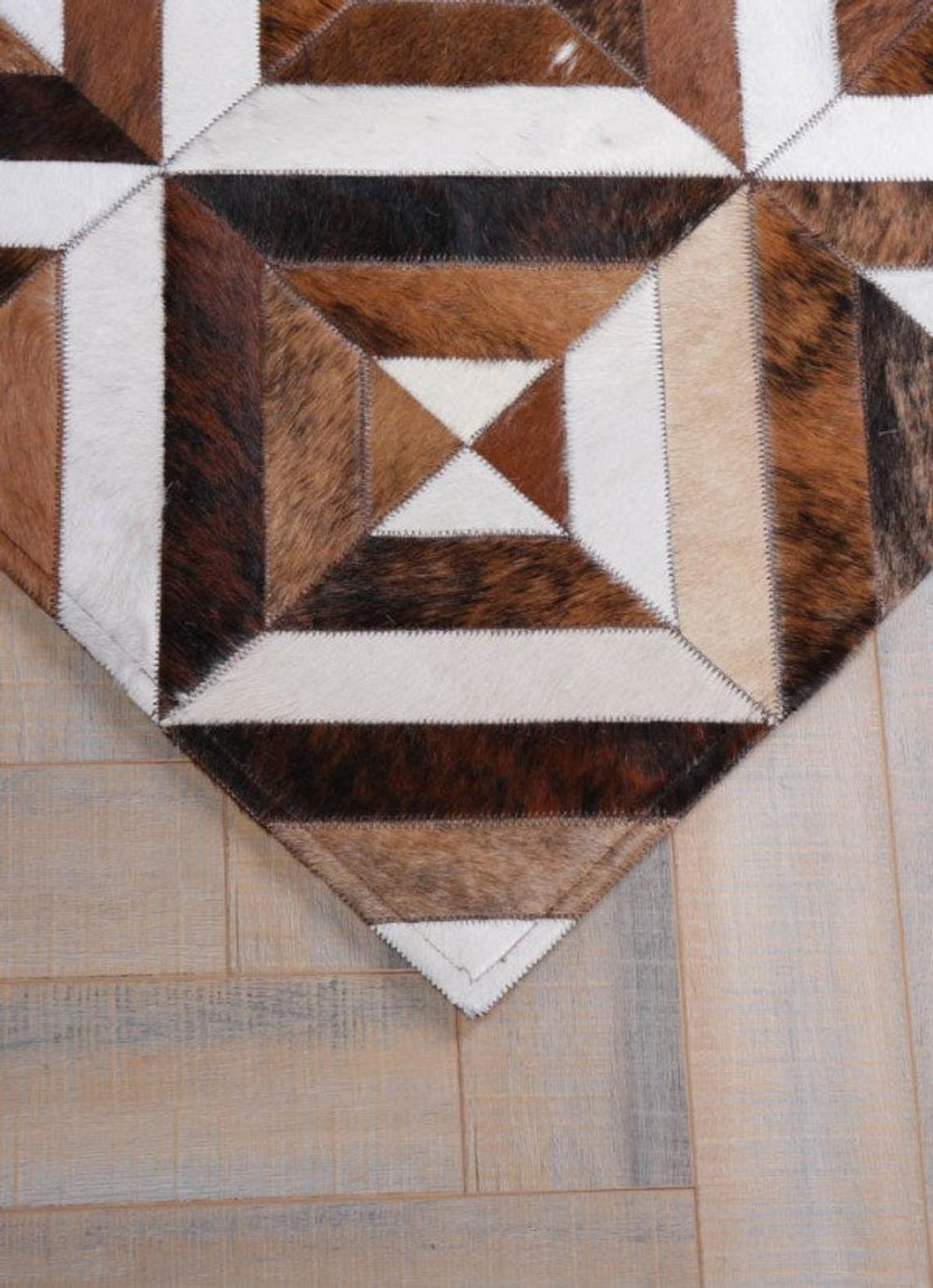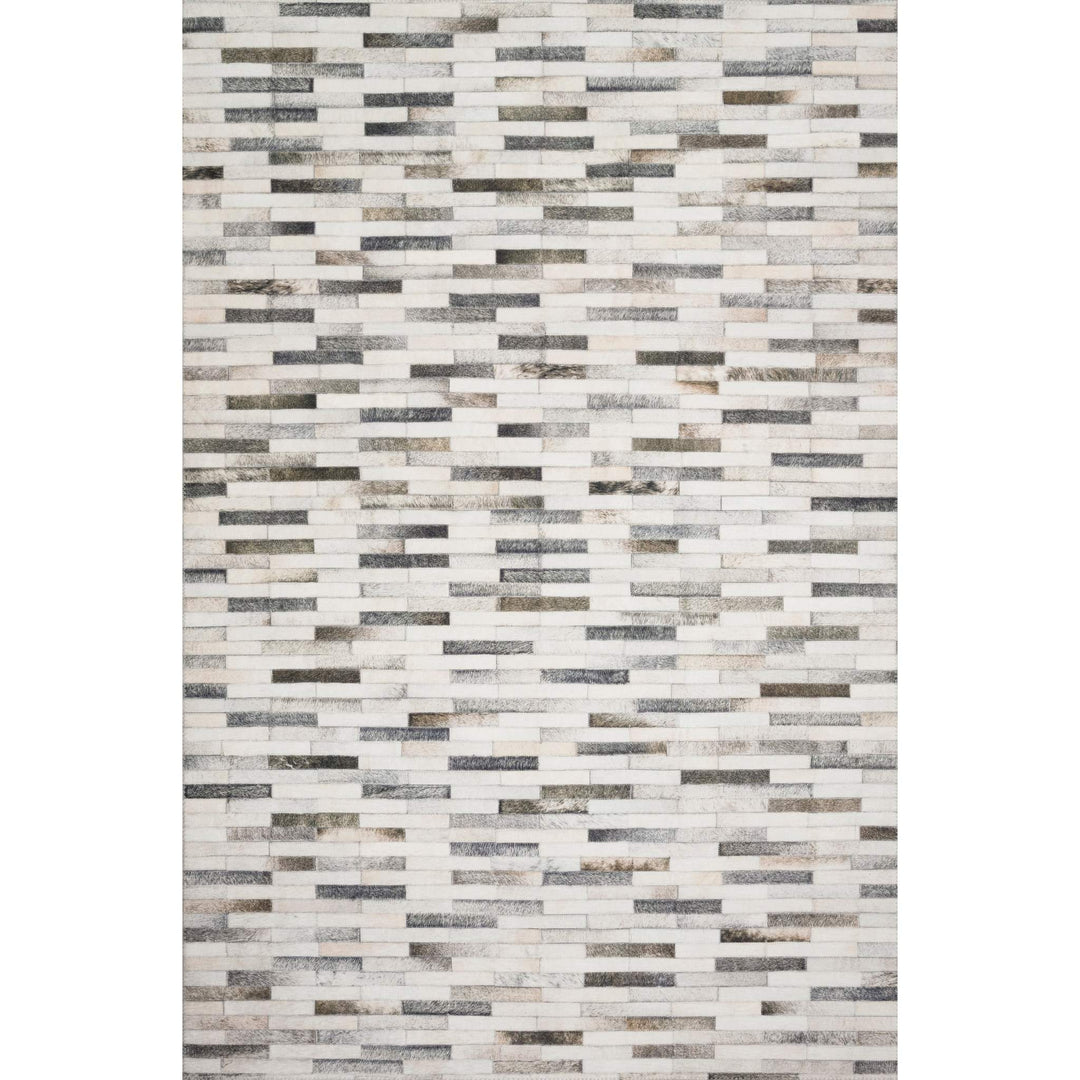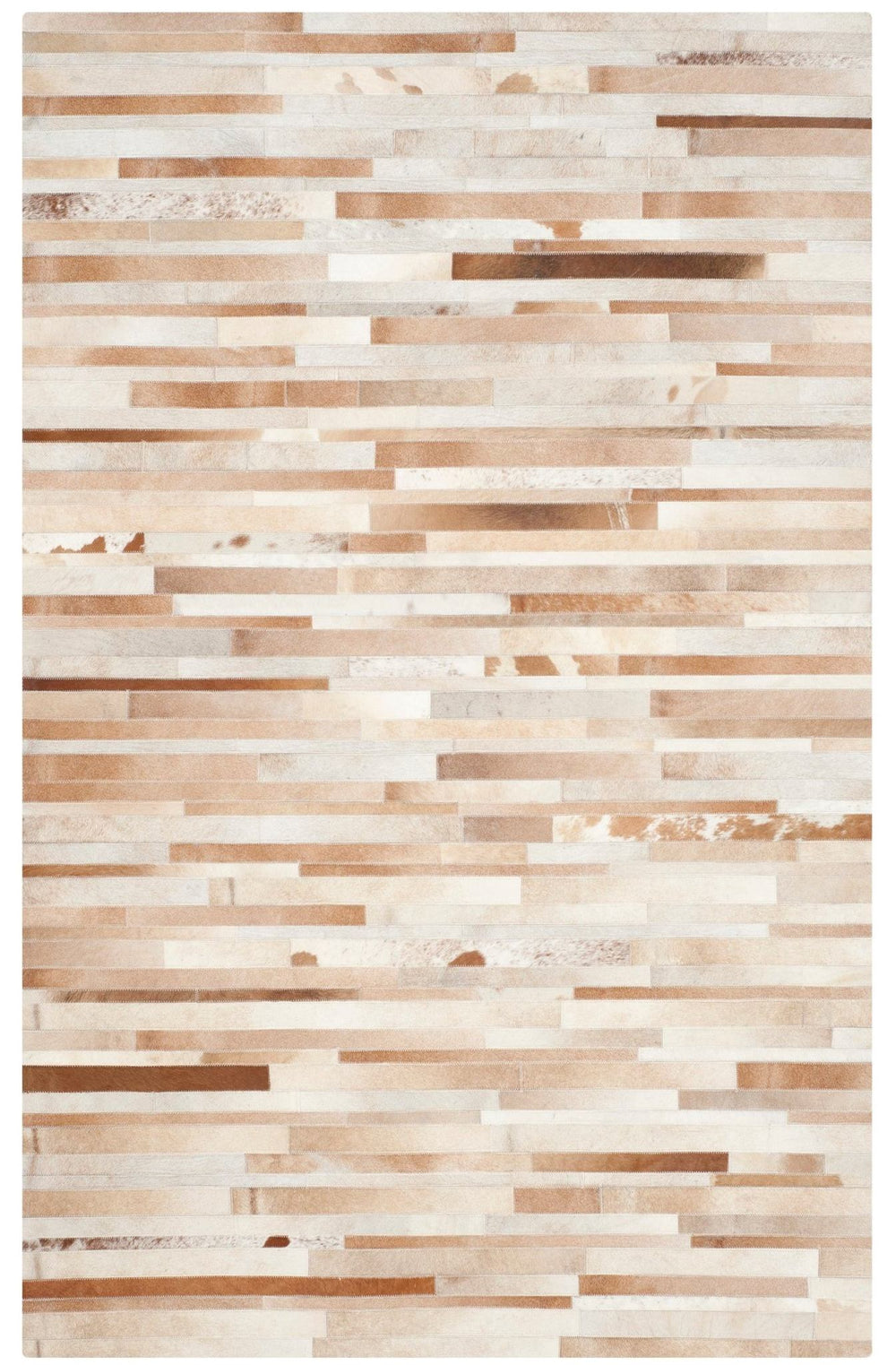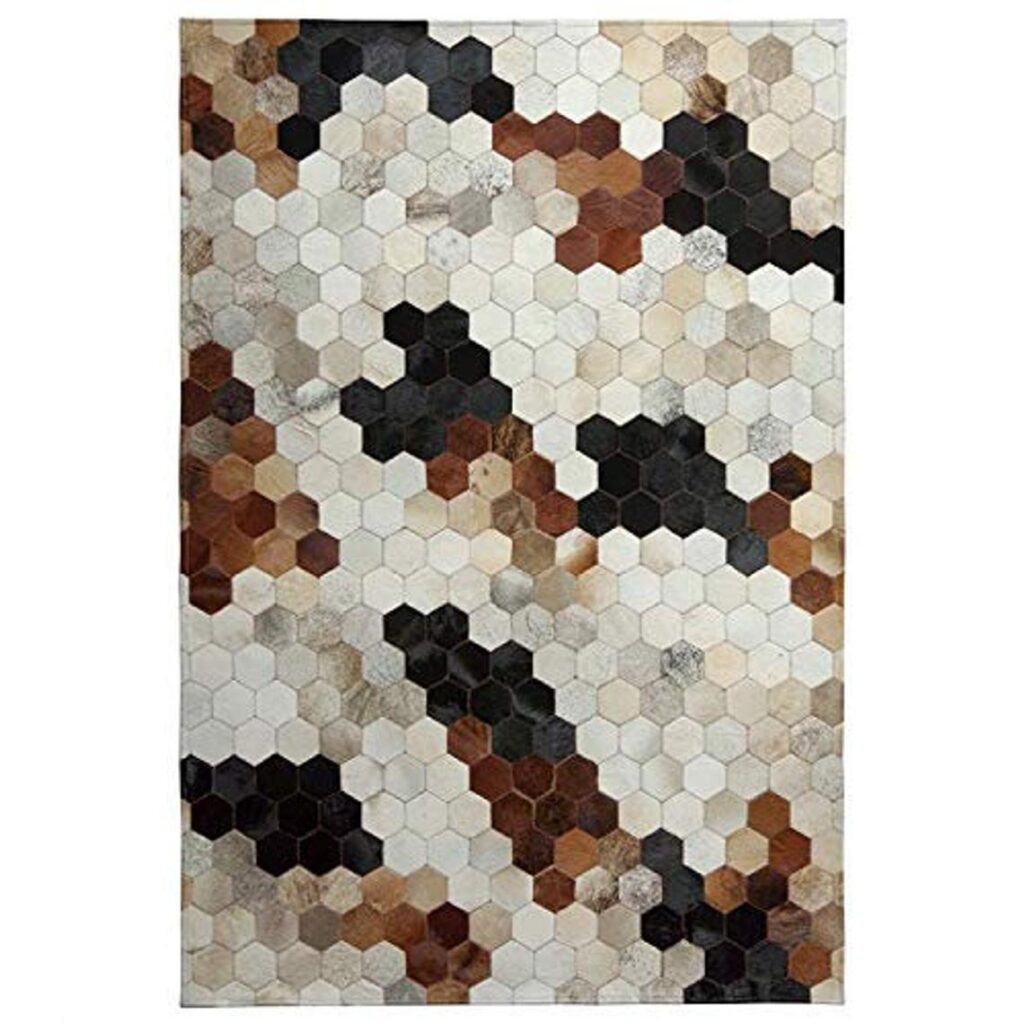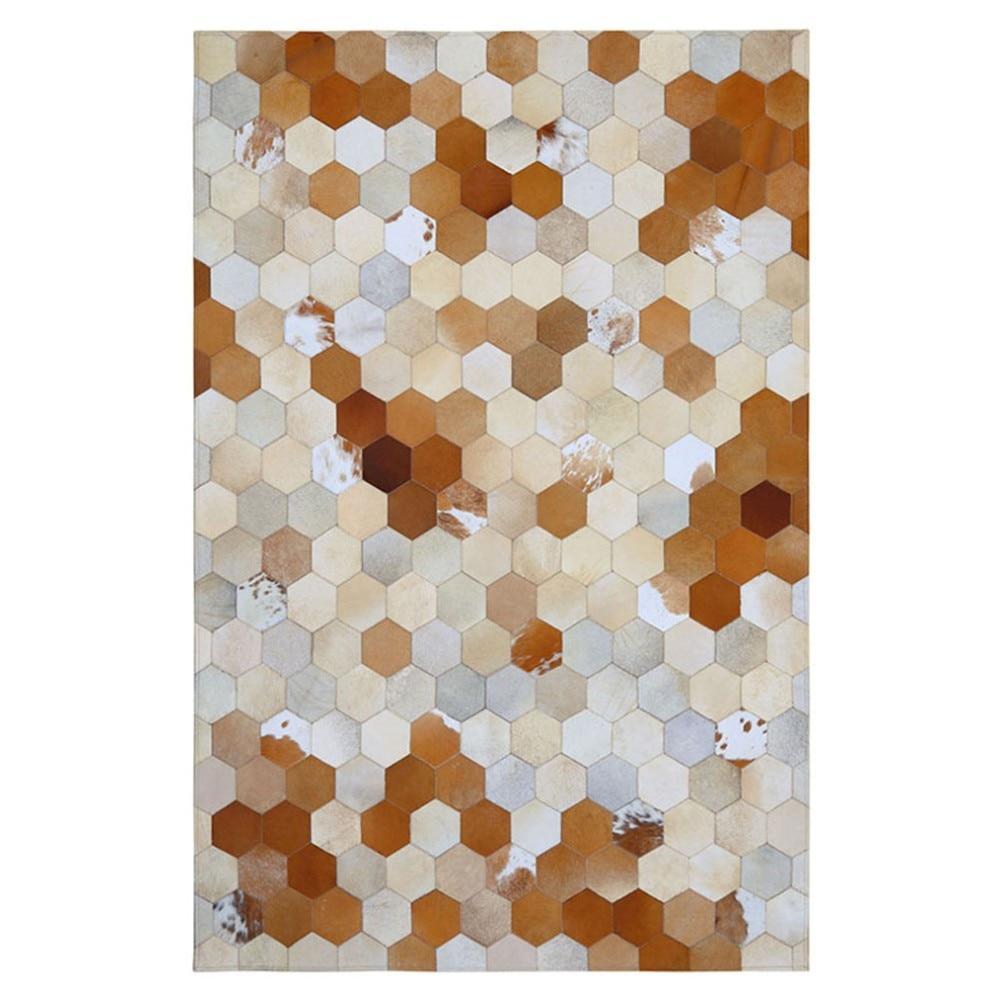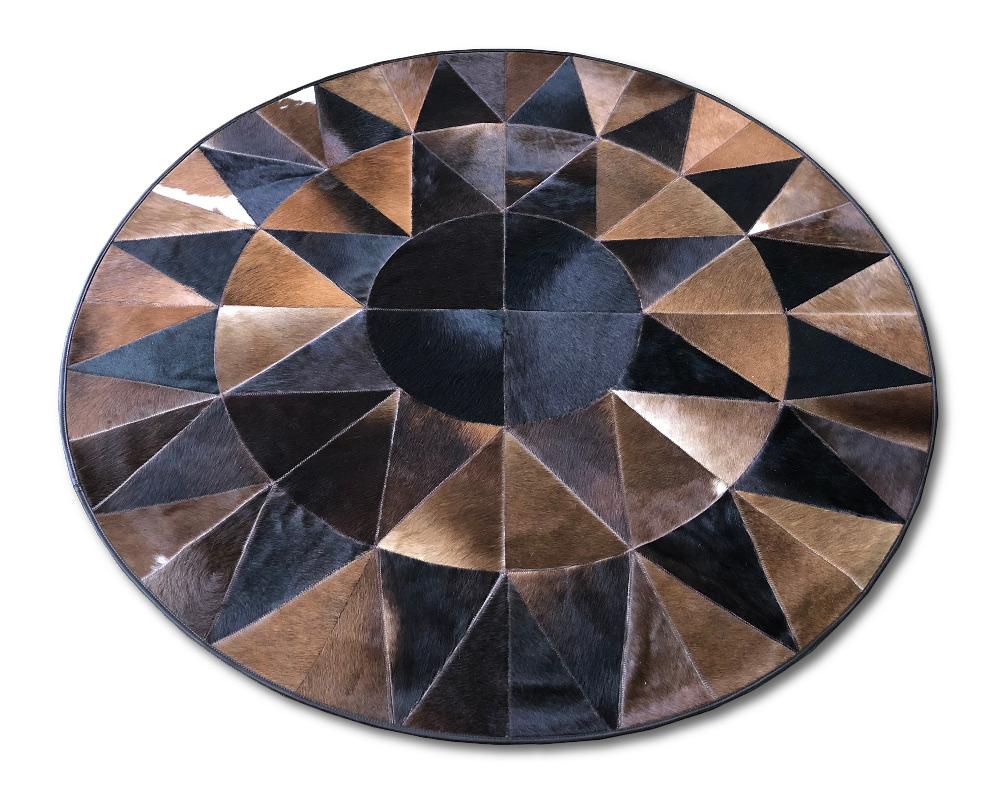To clean your cowhide rug like a professional, begin with regular maintenance, which includes weekly vacuuming in the direction of the hair to prevent dirt buildup. Spot clean spills promptly using a damp cloth and mild soap; avoid soaking the rug. For stubborn stains, apply eucalyptus oil to grease marks and use diluted shampoo for general stains. Minimize moisture to protect the hide, and consider professional cleaning every six to twelve months. By adhering to these techniques, you can extend the rug's lifespan, ensuring its beauty persists. Explore further to discover more essential care tips and techniques.
Overview of Cowhide Rugs

Cowhide rugs are crafted from the cured hides of cattle, utilizing either vegetable or chrome tanning processes to ensure durability and aesthetic appeal. These rugs typically range in size from 20 to 50 square feet, with larger options available through the merging of multiple hides. Each cowhide rug is unique, showcasing a distinctive array of colors and patterns that can enhance any interior design scheme.
The inherent qualities of cowhide make these rugs suitable for various settings, including high-traffic areas such as hallways and living rooms. The durability of cowhide allows it to withstand wear while maintaining its visual charm. Notably, the structure of these rugs features corners that are thinner than the central region, which contributes to their overall flexibility and adaptability in different spaces.
While cowhide rugs create a cozy ambiance and soften angular designs, it is essential to consider their care requirements. High exposure to heat can lead to curling, so it is advisable to place them in cooler areas.
Maintaining their shape can be as simple as sprinkling minimal water when necessary, ensuring that these rugs remain a long-lasting addition to any home.
Benefits of Owning a Cowhide Rug

The advantages of owning a cowhide rug extend beyond mere aesthetics, offering both practical and sensory benefits. One of the most notable features is their durability; crafted from leather, cowhide rugs can withstand years of wear and tear, making them suitable for high-traffic areas in the home.
Their unique textures and patterns add an element of sophistication to various interior designs, allowing for seamless integration into contemporary and traditional settings alike.
Additionally, cowhide rugs are hypoallergenic, often free from the allergens and fragrances found in synthetic materials. This quality makes them an excellent choice for individuals with sensitivities.
The soft and pliable texture provides comfort underfoot, enhancing the overall atmosphere of a room.
Maintenance is another advantage, as these rugs are relatively easy to clean. Liquid spills tend to pool on the surface, simplifying the cleanup process.
Furthermore, their natural stain resistance helps prolong their life, reducing the frequency of replacement.
Regular Maintenance Essentials

Consistency in maintenance is crucial for preserving the beauty and longevity of cowhide rugs. Regular upkeep not only enhances their appearance but also extends their lifespan, making them a wise investment for your home.
A fundamental practice is vacuuming, which should be done at least once a week. It is essential to vacuum in the direction of the hair to avoid damaging the fibers and to effectively remove dirt and dust.
Periodically shaking the rug outdoors can also help dislodge any trapped debris. For deeper cleaning, using a soft-bristled brush can assist in removing any stubborn dirt without harming the hide. Care should be taken to treat the rug gently, akin to maintaining a new vehicle, to preserve its integrity.
Furthermore, regular inspections for spills or stains are vital, as prompt attention can prevent more permanent damage. Avoid using excessive water and harsh chemicals, as these can compromise the rug's structure.
Cleaning Methods Explained

Understanding the appropriate cleaning methods for cowhide rugs is essential to maintaining their beauty and durability. These rugs, while inherently resilient, require specific care to preserve their unique characteristics. Primarily, minimal water usage is crucial; soaking can cause irreversible damage. Instead, spot cleaning with a damp cloth is advisable for addressing localized stains.
For routine maintenance, vacuuming in the direction of the hair prevents dirt accumulation and preserves the rug's texture. Additionally, using specialized cleaners designed for cowhide can effectively remove dirt without compromising the material. It is also beneficial to brush the rug with hard bristles to dislodge embedded debris.
In cases of deeper cleaning needs, professional services are recommended. These experts utilize techniques that ensure thorough cleaning while safeguarding the integrity of the hide. Regular professional cleaning not only refreshes the rug but can also extend its lifespan significantly.
Expert Stain Removal Techniques

Addressing stains on cowhide rugs requires specific techniques to ensure effective removal without damaging the material. The first step in stain removal is to act promptly. For liquid spills, gently dab the area with a paper towel to absorb excess moisture, avoiding any rubbing that could spread the stain.
For food stains, carefully scrape off any solid residue using a butter knife, then treat the area with a damp cloth and a mild, non-alkaline soap.
Grease stains necessitate a slightly different approach. Start by lightly scraping the area, then apply a small amount of eucalyptus oil, gently rubbing it with a clean cloth until the stain fades.
For general stains, a wet sponge with diluted shampoo can be effective; rinse the area with a clean cloth afterward to eliminate soap residue.
It is essential to remember that excessive water can damage the rug, so minimal moisture is key. Regular maintenance and the proper application of these techniques can help preserve the beauty and integrity of your cowhide rug, ensuring it remains a stunning feature in your home for years to come.
Professional Cleaning Advantages

When it comes to maintaining the quality and appearance of cowhide rugs, professional cleaning offers significant advantages that go beyond regular at-home care.
Professional cleaners possess specialized knowledge and experience in handling various rug materials, ensuring that the cleaning process is both effective and safe. Their expertise allows them to identify the specific needs of your cowhide rug, from proper cleaning techniques to the use of appropriate products that prevent damage.
One of the primary benefits of professional cleaning is the thoroughness achieved when removing deeply embedded dirt and stains. While regular maintenance can address surface-level issues, professionals employ advanced methods that penetrate deeper, revitalizing the rug's appearance.
Moreover, regular professional cleaning can extend the lifespan of your rug, preserving its natural beauty and texture for years.
Convenience is another key advantage, as many professional services offer pick-up and delivery, saving you time and effort.
Additionally, the satisfaction reported by customers highlights the transformative results delivered by these services, often leaving rugs looking new again.
Care Basics for Cowhide Rugs

Maintaining the beauty and longevity of cowhide rugs requires a straightforward approach to care. These rugs are known for their durability and natural stain resistance, making them ideal for high-traffic areas in any home.
Regular maintenance is essential and can be easily achieved through simple practices. Shaking or brushing the rug periodically helps to dislodge embedded dirt, while vacuuming is effective in removing dust and allergens.
When it comes to cleaning, using mild soaps such as baby shampoo or liquid castile soap is recommended for treating stains. It is crucial to avoid excess water, as it can damage the rug's backing and cause deformation. Instead, spot cleaning with a damp cloth is often sufficient to address spills or stains.
Additionally, placing the rug away from direct sunlight and heat sources can prevent curling and fading. For optimal care, treating a cowhide rug with the same attentiveness as you would a new automobile will help maintain its quality over time.
Vacuuming Tips for Cowhide

Proper vacuuming is essential for maintaining the appearance and longevity of your cowhide rug.
To achieve effective cleaning, it is important to choose a vacuum that uses only suction, avoiding rotating brushes that can damage the fibers.
Regular vacuuming, ideally once a week, helps manage dust and allergens, while addressing stubborn dirt may require additional techniques such as shaking or brushing the rug.
Proper Vacuuming Technique
Effective vacuuming is essential for preserving the beauty and longevity of your cowhide rug. To maintain its unique characteristics, it is important to use proper techniques during the vacuuming process.
Begin by utilizing only the suction function of your vacuum cleaner, as this prevents damage to the fibers. Avoid using any rotating brush attachments, which can pull at the hair and lead to premature wear or loss.
When vacuuming, always proceed in the direction of the hair growth. This approach not only ensures a thorough clean but also helps maintain the rug's natural appearance.
Regular vacuuming is recommended to eliminate dirt, dust, and allergens that can accumulate over time. Aim for at least once a week, or more frequently in high-traffic areas.
In addition to vacuuming, consider occasionally shaking out the rug outdoors to dislodge any trapped debris. If your vacuum cleaner includes an upholstery nozzle, it can be used safely for edges and corners.
Choosing the Right Vacuum
When selecting a vacuum for your cowhide rug, it is crucial to consider models specifically designed to handle delicate materials. Traditional vacuums may not be suitable, as their rotating brushes can damage the hair and compromise the rug's integrity.
Instead, opt for vacuums that utilize only suction, as this method effectively removes dirt without causing wear. A vacuum with adjustable suction settings is ideal, allowing you to customize the intensity based on the rug's thickness and hair length.
Additionally, a vacuum with an upholstery attachment or nozzle is recommended for targeted cleaning. This tool is gentle on the surface while efficiently dislodging trapped debris.
When vacuuming, remember to always follow the direction of the hair growth. This approach helps maintain the rug's appearance and prevents hair loss.
Regular vacuuming, ideally once a week, will keep your cowhide rug looking pristine and free from allergens.
Frequency of Vacuuming
Maintaining the cleanliness of your cowhide rug is essential for preserving its beauty and longevity. Regular vacuuming is a fundamental practice that should not be overlooked. Depending on foot traffic and usage, it is advisable to vacuum your cowhide rug at least once a week. This frequency helps to remove dirt, dust, and allergens that can accumulate over time, ensuring the rug remains in optimal condition.
When vacuuming, always use the suction function without any rotating brushes, as these can damage the delicate hair fibers. Additionally, vacuuming in the direction of the hair growth is crucial, as this technique prevents fraying and maintains the rug's appearance. For high-traffic areas, consider increasing the frequency to two or three times a week to better manage dirt and debris.
In addition to regular vacuuming, shaking the rug outdoors occasionally can help dislodge any trapped particles. By adhering to a consistent vacuuming schedule and employing proper techniques, you can effectively prolong the life of your cowhide rug while maintaining its aesthetic appeal.
Taking these steps ensures that your investment continues to enhance your living space for years to come.
Handling Stubborn Dirt
Stubborn dirt on cowhide rugs can pose a challenge, but employing the right vacuuming techniques can significantly enhance cleaning efficiency.
To effectively manage dirt buildup while preserving the integrity of the hide, consider the following vacuuming tips:
- Use Suction Only: Ensure your vacuum is set to suction mode only. Avoid using rotating brushes or beater bars, as these can damage the delicate hair and texture of the cowhide.
- Vacuum in the Hair Direction: Always vacuum in the direction of the hair growth. This technique not only minimizes hair loss but also prevents the fibers from becoming matted.
- Select the Right Attachment: Utilize a nozzle or upholstery attachment to reach into corners and crevices without causing harm. This will help dislodge more stubborn dirt effectively.
- Regular Vacuuming: Establish a routine for vacuuming your cowhide rug, ideally once a week. Consistent maintenance will prevent dirt from settling deeply into the fibers, ensuring a cleaner and more vibrant rug over time.
Steam Cleaning Guidelines

When considering steam cleaning for your cowhide rug, proper preparation is essential to ensure effective results without damaging the material.
Employing the correct steam cleaning technique will maintain the rug's integrity, while post-cleaning care tips can help prolong its lifespan.
Additionally, understanding the appropriate frequency for steam cleaning will help you maintain your rug's appearance and hygiene over time.
Preparation Before Steam Cleaning
Before initiating the steam cleaning process for your cowhide rug, it's essential to prepare adequately to ensure optimal results and protect the rug's integrity. Proper preparation can significantly enhance the effectiveness of the cleaning method while safeguarding the material from potential damage.
Here are four crucial steps to follow:
- Vacuum Thoroughly: Begin by vacuuming the rug to remove loose dirt, dust, and debris. This step is vital as it prevents particles from becoming embedded in the fibers during steam cleaning.
- Inspect for Stains: Carefully examine the rug for any stains or areas that require special attention. Identifying these spots beforehand will allow you to address them appropriately during the cleaning process.
- Check the Steam Cleaner: Ensure that your steam cleaner is in good working condition. Check the water reservoir and clean any filters if necessary to guarantee optimal steam output.
- Test a Small Area: Before applying steam to the entire rug, test a small, inconspicuous area to ensure that the steam does not adversely affect the hide. This precaution can help prevent any unexpected reactions.
Proper Steam Cleaning Technique
Following the preparation steps ensures a smoother steam cleaning process for your cowhide rug.
Begin by vacuuming the rug thoroughly to remove loose dirt and debris, working in the direction of the hair to prevent damage. Once vacuumed, set your steam cleaner to a low moisture setting to avoid over-saturating the hide, which can lead to backing damage.
When steam cleaning, maintain a consistent distance between the nozzle and the rug, typically around six inches. Move the cleaner in the direction of the hair growth, applying even pressure and allowing the steam to penetrate without lingering too long in one spot. This technique prevents overheating and potential curling of the hide.
After completing the steam cleaning, it's essential to allow the rug to air dry in a well-ventilated space, away from direct sunlight or heat sources. This drying process helps maintain the rug's shape and texture.
Regular steam cleaning can refresh the rug, removing bacteria and odors, making it an effective method for deep cleaning while preserving the unique properties of your cowhide rug.
Post-Cleaning Care Tips
Post-cleaning care for your cowhide rug is crucial to preserving its appearance and longevity after steam cleaning. Following this process, it is essential to implement specific care strategies to ensure the rug remains in top condition.
Proper post-cleaning practices will help maintain the integrity of the hide and keep it looking vibrant.
1. Air Drying: Allow the rug to air dry naturally in a well-ventilated area.
Avoid direct sunlight or heat sources, as these can cause fading or curling.
2. Gentle Brushing: Once dry, use a soft-bristled brush to restore the natural hair direction.
This step helps maintain the texture and appearance of the hide.
3. Avoid Heavy Furniture: Refrain from placing heavy furniture on the rug for at least 48 hours post-cleaning.
This precaution prevents any potential flattening of the fibers.
4. Regular Maintenance: Incorporate regular maintenance, such as vacuuming and shaking out debris, to prevent dirt buildup and extend the life of your cowhide rug.
Frequency of Steam Cleaning
Determining the appropriate frequency for steam cleaning your cowhide rug is essential for maintaining its pristine condition and extending its lifespan.
Generally, it is recommended to steam clean your rug every six to twelve months, depending on its usage and the amount of foot traffic it endures. For rugs placed in high-traffic areas, such as living rooms or hallways, a more frequent cleaning schedule may be necessary, with sessions every four to six months.
Before steam cleaning, always vacuum the rug thoroughly to remove loose dirt and debris. This step is crucial as it ensures that the steam cleaning process is effective and prevents dirt from being pushed deeper into the fibers.
During the steam cleaning process, it is essential to work in the direction of the hair to maintain the rug's texture and appearance.
While steam cleaning is a powerful method for revitalizing cowhide rugs, over-saturation should be avoided to protect the backing material.
In cases of spills or stains, spot cleaning should be prioritized. By adhering to these guidelines, you can ensure that your cowhide rug remains clean, hygienic, and visually appealing for years to come.
Stain Treatment Strategies

Stain treatment for cowhide rugs requires prompt action to minimize damage and maintain their aesthetic appeal.
While these rugs possess natural stain resistance, understanding specific cleaning techniques and utilizing specialized cleaners can enhance the effectiveness of stain removal.
Addressing common stains with appropriate methods ensures the longevity and beauty of your cowhide rug.
Immediate Action for Stains
When a spill occurs on your cowhide rug, prompt action is essential to prevent deeper penetration and potential staining.
Cowhide rugs, known for their durability and natural resistance to stains, still require immediate attention to maintain their pristine appearance. By following a systematic approach, you can effectively manage spills and minimize damage.
- Blot the Spill: Use a clean, absorbent paper towel or cloth to gently blot the stain. Avoid rubbing, as this can push the liquid deeper into the fibers.
- Use Mild Soap: If the spill is stubborn, mix a small amount of gentle shampoo with water. Dampen a cloth with this solution and gently dab the stained area, working from the outside in.
- Rinse and Blot: After treating the stain, dampen another clean cloth with plain water to rinse the area. Blot any excess moisture to prevent further soaking.
- Air Dry: Allow the rug to air dry completely. Avoid direct sunlight or heat sources, as these can cause discoloration or curling.
Prompt attention and proper techniques can significantly extend the life of your cowhide rug and preserve its beauty.
Natural Stain Resistance Benefits
The inherent resilience of cowhide rugs offers a significant advantage in managing everyday spills and stains. These rugs possess natural stain-resistant properties, allowing them to repel many common liquids, such as water, wine, and juice.
The unique structure of cowhide means that spills tend to remain on the surface rather than penetrating deeply, making cleanup easier and reducing the risk of lasting damage.
For typical spills, a swift response is key. Simply blotting the area with a clean, absorbent cloth can often suffice to lift the liquid before it has a chance to settle.
The rug's natural fibers are designed to withstand a variety of substances without compromising their integrity. This innate resistance to staining means that regular maintenance—such as vacuuming and occasional shaking—can help maintain the rug's pristine appearance.
However, while cowhide rugs are indeed resistant to many stains, it is essential to treat any spills promptly and with care.
This proactive approach, combined with their natural properties, ensures that your cowhide rug remains a beautiful and functional addition to your home for years to come.
Specialized Cleaners and Techniques
How can specialized cleaners enhance the maintenance of cowhide rugs? Utilizing specialized cleaners is essential for preserving the integrity and appearance of cowhide rugs, particularly when tackling more stubborn stains or dirt.
These products are formulated to work effectively without causing damage to the leather, ensuring that your rug maintains its unique beauty over time.
Here are four key strategies for using specialized cleaners:
- Identify the Stain Type: Understanding the nature of a stain can guide you in choosing the right cleaner. Some products target specific stains, such as grease or ink.
- Test on Small Areas: Always conduct a patch test on a hidden area to ensure the cleaner does not discolor or damage the rug.
- Follow Manufacturer Instructions: Adhering to the guidelines on the cleaner's label ensures optimal results while minimizing the risk of harm.
- Regular Application: Incorporating specialized cleaners into your routine maintenance can significantly prolong the life of your cowhide rug, keeping it looking fresh and vibrant.
Common Stains and Solutions
Addressing common stains on cowhide rugs requires an understanding of effective treatment strategies to preserve their beauty and longevity. Spills such as milk, juice, or wine can typically be managed by blotting the area gently with a paper towel, ensuring not to rub, as this may spread the stain.
For greasy substances, sprinkle cornstarch over the stain to absorb the oil, leaving it for several hours before vacuuming.
Food stains necessitate a slightly different approach. Gently scrape any excess food with a butter knife, followed by a damp cloth and a non-alkaline soap solution to clean the area.
Sticky substances can be treated with a mild soap like Dawn or Windex, applied with a soft cloth.
For tougher stains, such as ink, hand sanitizer can be effective, while red wine may require a specialized cleaner.
It is essential to treat stains promptly, as delays can lead to deeper penetration into the hide, making removal more difficult.
Regular inspection and maintenance of your cowhide rug can significantly reduce the risk of permanent staining, ensuring your investment remains in pristine condition.
Grease Stain Removal Tips

When it comes to removing grease stains from your cowhide rug, prompt action is essential for effective treatment.
Start by blotting any fresh oil stains with a paper towel to absorb excess grease, followed by applying cornstarch to draw out the remaining oil.
After allowing the cornstarch to sit for several hours, vacuum the area to remove the residue, repeating the process if necessary to achieve optimal results.
Blotting Fresh Oil Stains
To tackle fresh oil stains on your cowhide rug effectively, it's crucial to act quickly and avoid rubbing, as this can spread the stain further.
The following steps will guide you in managing fresh oil stains without compromising the integrity of the rug.
1. Blot the Stain: Immediately use a clean, dry cloth or paper towel to gently blot the stain, absorbing as much oil as possible.
Do not rub; this can push the oil deeper into the fibers.
2. Air Dry: Allow the area to air dry naturally.
Avoid using heat sources, as they can damage the hide.
3. Use a Clean Cloth: After the area is dry, take a new clean cloth and lightly dab the stained area.
This step helps lift residual oil.
4. Inspect the Stain: Finally, examine the area to determine if the stain persists.
If necessary, repeat the blotting process until the oil is adequately removed.
Cornstarch Absorption Method
For effective removal of grease stains on your cowhide rug, the cornstarch absorption method offers a reliable solution. This technique utilizes cornstarch's natural oil-absorbing properties to lift grease from the rug's surface without damaging the hide.
To begin, gently blot any excess grease with a paper towel, avoiding vigorous rubbing, which can worsen the stain.
Next, generously apply a layer of cornstarch directly onto the stain. Ensure that the area is adequately covered, as this will enhance absorption.
Allow the cornstarch to sit undisturbed for several hours, or preferably overnight, to maximize its effectiveness. During this time, the cornstarch will draw the grease out of the fibers.
Once the waiting period is complete, carefully vacuum the cornstarch from the rug. This process should remove the grease stain, but if any residue remains, repeat the application as needed.
It is essential to handle the rug delicately throughout this process to maintain its integrity. By utilizing this method, you can effectively manage grease stains while preserving the beauty and quality of your cowhide rug.
Vacuuming Residue Removal
While the cornstarch absorption method is effective for lifting grease stains, proper vacuuming is crucial for removing any residual particles from the cowhide rug. This step ensures that your rug not only looks clean but also maintains its durability and texture.
After allowing the cornstarch to absorb the grease, follow these vacuuming tips for optimal results:
- Use the Suction Function Only: Employ a vacuum that has a suction-only setting to avoid damaging the rug's fibers. Avoid using rotating brushes, which can lead to hair loss.
- Vacuum in the Direction of the Hair: This technique helps maintain the natural appearance of the rug, preventing any disruption to its texture.
- Utilize an Upholstery Attachment: A nozzle or upholstery attachment is ideal for effectively cleaning the rug without causing harm.
- Regular Vacuuming Schedule: Establish a routine vacuuming schedule to prevent dirt accumulation, ideally once a week, or more frequently in high-traffic areas.
Adhering to these vacuuming practices will enhance the cleanliness and longevity of your cowhide rug, preserving its unique beauty for years to come.
Repeat Process if Necessary
Persistent grease stains on a cowhide rug may require a repeat of the cornstarch absorption process for complete removal.
Initially, it is crucial to blot the stain with paper towels to remove any excess oil. Following this, generously apply a layer of cornstarch over the affected area. The cornstarch serves as an absorbent, drawing out the grease from the fibers of the rug. Allow it to sit undisturbed for several hours, or preferably overnight, to maximize absorption.
After the allotted time, vacuum the cornstarch thoroughly from the rug. If the stain remains visible, do not hesitate to repeat the process. Multiple applications may be necessary, especially for older or more stubborn stains. Each repetition provides the cornstarch with another opportunity to extract residual grease, thereby enhancing the likelihood of complete removal.
For optimal results, monitor the rug's condition after each treatment.
If grease stains persist despite these efforts, consider consulting a professional cleaning service specializing in cowhide rugs. Professionals possess specialized techniques and tools that can effectively address challenging stains while ensuring the integrity of your rug is maintained.
General Cleaning Techniques

Maintaining the pristine condition of a cowhide rug requires a thoughtful approach to general cleaning techniques. Regular upkeep is crucial for preserving the rug's beauty and longevity.
Implementing effective cleaning methods can significantly enhance its appearance and prevent long-term damage.
Here are four essential techniques for cleaning your cowhide rug:
- Vacuum Regularly: Use a vacuum with only suction capabilities to avoid damaging the rug's hair. Vacuum in the direction of hair growth to effectively remove dust and debris.
- Shake It Out: Periodically take the rug outside and shake it vigorously to dislodge trapped dirt. This method is simple yet effective for maintaining a clean surface.
- Brush with Care: Utilize a soft-bristled brush to gently remove dirt without harming the hide. Brush in the direction of the hair to maintain the rug's natural appearance.
- Spot Clean Stains Promptly: For minor spills, dab the area with a damp cloth immediately. Use a mild soap solution if necessary, ensuring to avoid excessive moisture.
Washing and Drying Best Practices

When it comes to washing and drying your cowhide rug, understanding the best practices is essential for maintaining its integrity and appearance.
Proper washing techniques, along with appropriate drying methods, can significantly enhance the rug's condition while avoiding potential damage.
This section will cover key considerations for machine washing, effective air drying, and common pitfalls to avoid during the cleaning process.
Washing Techniques Overview
Washing techniques for cowhide rugs require careful consideration to preserve their unique qualities while effectively removing dirt and stains.
Unlike traditional rugs, cowhide has specific cleaning needs that must be addressed to maintain its integrity. A few best practices can guide you through the washing process.
- Minimize Water Usage: Excessive water can damage the hide, leading to stiffness and loss of luster. Use a damp cloth for spot cleaning rather than soaking the rug.
- Appropriate Cleaners: Opt for specialized cleaners designed for cowhide. Avoid harsh chemicals that can strip the natural oils from the leather.
- Gentle Scrubbing: When tackling stains, use a soft-bristled brush or cloth. Scrub gently in the direction of the hair to avoid damaging the fibers.
- Test Before Full Application: Always conduct a spot test on a small, inconspicuous area to ensure that the cleaning method does not affect the color or texture of the rug.
Drying Methods Recommendations
After washing a cowhide rug, proper drying techniques are essential to preserve its integrity and appearance. The first step is to gently blot the rug with a clean, absorbent towel to remove excess moisture.
Avoid wringing or twisting the hide, as this can lead to deformation. Once the initial moisture is absorbed, lay the rug flat in a well-ventilated area, ideally away from direct sunlight and heat sources. Excessive heat can cause the rug to curl or become brittle over time.
If possible, prop the rug up on a drying rack or hang it in a shaded area to facilitate airflow. This method allows the hide to dry evenly while preventing musty odors that can develop in damp conditions.
It is important to note that air drying is preferable to machine drying, as the latter can compromise the rug's structure and texture.
Regularly check the rug during the drying process to ensure it dries completely. Once dry, gently shake or brush the rug to restore its natural appearance.
Following these drying recommendations will help maintain the longevity and aesthetic appeal of your cowhide rug.
Machine Washing Considerations
Considering the potential benefits of machine washing, it is important to understand the implications and best practices associated with this method. Machine washing can refresh a cowhide rug, especially if it has accumulated significant stains or dirt. However, caution is paramount to avoid damaging the rug.
Here are four essential considerations when machine washing your cowhide rug:
- Water Temperature: Always use cold water to prevent shrinkage and maintain the integrity of the hide. Hot water can cause irreversible damage.
- Gentle Cycle: Select a gentle or delicate cycle on your washing machine to minimize agitation. Excessive movement can distort the rug's shape.
- Detergent Choice: Opt for a mild detergent that is free from harsh chemicals. This ensures the preservation of the natural fibers and colors.
- Pre-treatment: Treat any stubborn stains with a specialized cleaner before machine washing. This enhances the chances of complete stain removal during the wash cycle.
Air Drying Tips
How can you effectively air dry your cowhide rug to maintain its quality? After machine washing, the drying process is crucial to preserving the rug's integrity and appearance.
Begin by laying the rug flat on a clean, dry surface, preferably outdoors in a shaded area to avoid direct sunlight, which can cause fading or curling. Ensure that the surface is smooth to prevent any creases or marks from forming during the drying process.
It is essential to avoid hanging the rug, as this can distort its shape and lead to uneven drying. If possible, use a fan to circulate air around the rug, promoting even drying while reducing moisture retention.
Periodically check the rug for dryness, as the air drying time may vary depending on humidity and temperature levels.
Additionally, refrain from using heat sources such as radiators or hair dryers, as excessive heat can harm the hide.
Once the rug is completely dry, gently shake it to restore its original shape and fluff the hair. Following these air drying tips will help ensure your cowhide rug remains in excellent condition for years to come.
Avoiding Common Mistakes
Avoiding common mistakes during the washing and drying of cowhide rugs is essential to preserve their quality and longevity. Many owners inadvertently harm their rugs by failing to follow best practices. Understanding these pitfalls can enhance your cleaning efforts.
- Over-saturating the Rug: Excessive water can damage the backing and lead to curling. Always use minimal water when cleaning, focusing on spot treatments instead.
- Using Harsh Chemicals: Strong detergents and cleaners can strip the natural oils from the hide, leading to stiffness and discoloration. Opt for gentle, pH-balanced cleaners specifically designed for leather.
- Ignoring Drying Techniques: Air drying is crucial after washing. Avoid direct sunlight or heat sources, which can warp the rug. Instead, lay it flat in a cool, well-ventilated area.
- Rubbing Stains: Rubbing can embed the stain deeper into the fibers. Instead, blot stains gently with a clean cloth to lift the substance without damaging the hide.
Additional Resources for Care

While maintaining a cowhide rug requires regular attention, additional resources can significantly enhance your care routine. Numerous video tutorials are available online, providing visual guidance on effective cleaning techniques and maintenance practices. These resources can be particularly beneficial for those new to cowhide care, illustrating step-by-step processes that are easy to follow.
In addition to videos, many websites offer text-based support for specific inquiries regarding cowhide rug maintenance. Engaging with these resources can help clarify doubts and provide expert advice tailored to individual circumstances.
Social media platforms are also valuable for staying updated on the latest care tips and techniques, as they often feature posts that highlight common challenges and solutions.
Furthermore, consider joining online communities or forums dedicated to home decor and rug care. These platforms encourage interaction among users, allowing you to share experiences and learn from others.
Lastly, exploring reputable retailers can provide access to additional cleaning products specifically formulated for cowhide rugs, ensuring you use the right tools for effective care and maintenance.
Frequently Asked Questions
Can Cowhide Rugs Be Used Outdoors?
Cowhide rugs are not recommended for outdoor use due to their sensitivity to moisture and UV exposure. Prolonged outdoor conditions can lead to deterioration, discoloration, and loss of texture, compromising their aesthetic and functional qualities.
How Do I Prevent Curling in My Cowhide Rug?
To prevent curling in your cowhide rug, maintain a consistent environment with moderate temperatures, avoid direct heat sources, and periodically sprinkle minimal water to restore shape. Regular vacuuming and professional cleaning also contribute to longevity and stability.
Are Cowhide Rugs Safe for Homes With Pets?
Cowhide rugs are generally safe for homes with pets due to their durability and hypoallergenic properties. Their natural stain resistance makes them suitable for high-traffic areas, although prompt cleaning of accidents is recommended to maintain appearance.
How Often Should I Professionally Clean My Cowhide Rug?
Professionally cleaning your cowhide rug is recommended every 12 to 18 months, depending on usage and exposure to spills. This frequency helps maintain its appearance, prolongs durability, and ensures thorough removal of embedded dirt and allergens.
What Should I Do if My Cowhide Rug Fades Over Time?
If your cowhide rug fades over time, consider repositioning it to reduce sun exposure, applying a specialized leather conditioner, or consulting a professional for restoration. Regular maintenance can also help preserve its vibrant appearance.
Conclusion
In conclusion, maintaining the beauty and longevity of cowhide rugs requires a systematic approach to cleaning and care. Regular maintenance, prompt stain removal, and adherence to proper washing techniques are essential for preserving their aesthetic appeal. Engaging professional cleaning services can further enhance the rug's condition when necessary. By following the guidelines outlined in this guide, owners can ensure their cowhide rugs continue to serve as elegant and durable focal points within their interior spaces.




